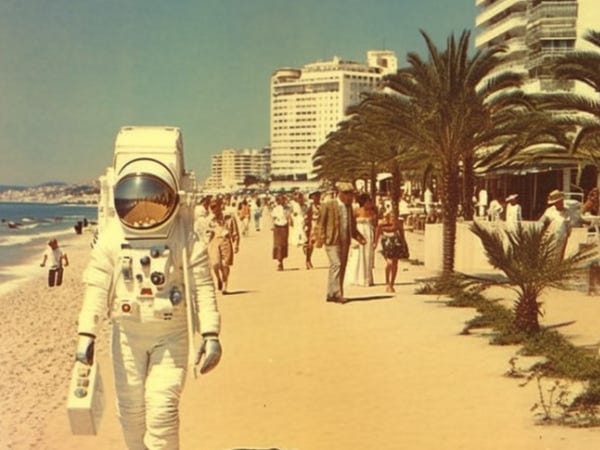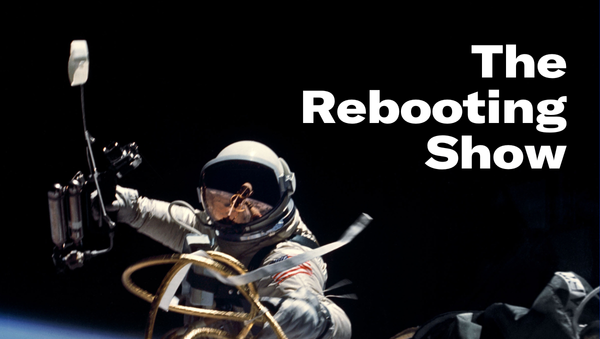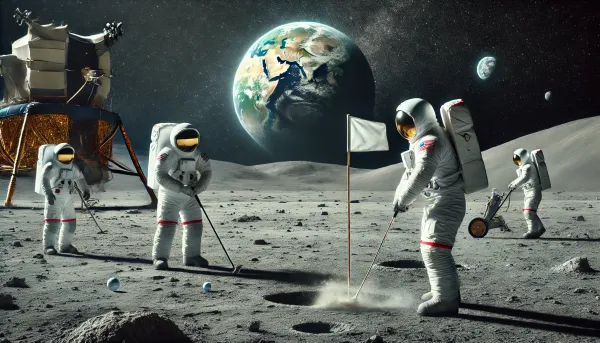AI in the Riviera
Efficiency beats craft
We wrapped up Day 3 of The New Attention Economy, presented by Kerv Interactive, with a focus on AI. We closed the day with a session about AI and creativity. Thanks to Mike Shields from Next in Media for contributing to this penultimate Riviera briefing. We’ll wrap up our coverage tomorrow with a final missive. Cannes is like a marathon: it gets ragged in the last few miles. First up, a message from Kerv.


What does it mean to measure consumer attention? Page context and quality certainly play a role, but with KERV Active Attention Index, you can also understand consumer attention with the video creative itself. Through this index, we measure the quality of deterministic user actions as they engage with interactive and shoppable videos.
Amuse-bouche
- Retail media reality check: There are an estimated 70 retail media networks. “There’s going to be consolidation,” said Claire Wyatt, vp of business strategy and marketing science at Albertsons.
- Programmatic reality check: “SPO and sustainability highlight all the hands that are in the pot,” said Christine Cook, CRO at Bloomberg.
-CTV reality check: If regulators crack down on IP addresses, “That’s going to be a massive shift,” said Chris Maccaro, CEO of ad tech firm Beachfront Media. “If that no longer is an option, we start pushing TV back to an unconnected world.”
- Ad outlook reality check: Things are definitely looking up, but nobody expects to have any visibility going forward - maybe for a long time. “Nobody has any clue right now about Q4,” said one seller. “That’s very unusual.” – BM, MS
AI arrives in Cannes

The underlying tension at Cannes is over what impact AI will have on the creative industries. After all, Cannes began as a way to honor commercial creative work back in the 1940s, when a bunch of French cinema owners created the event that became the carnival of capitalism it is today.
That’s why AI has emerged as a key theme of the week, in conversations at The New Attention Economy over nine hours on Monday through Wednesday, and the conversations I’ve had so far. Cannes is an interesting place to take a pulse check of AI because it is this contradictory mix of a “celebration of creativity” as a facade for the carnival of capitalism, which is an accurate reflection of how things really work.
In gift to newsletter writers and the hundreds of journalists in Cannes, the Croisette – the main artery of Cannes that runs along the fancy pants hotels and sprawling beach complexes –is under construction, leaving a total chaotic mess for lanyard execs to navigate. This is part of an overhaul project by an ambitious mayor who seems to have read up on Miami’s Bitcoin guy, and wants to clean up the shabbier parts of Cannes for the same luxury blandness you’ll find in the Miami’s Design District or in Dubai and Singapore.
The best parts of Cannes are the least glamorous, like the crappy basement casino tucked along the luxury stores on the Croisette. Beyond the glamorous facade, much of Cannes is a faded beach town past its prime. I’m staying away from the mania of the festival, and came across a lovely square last night of boules courts. A band had set up and families were swaying away the evening to French renditions of Johnny B Goode. Mayor McFromage would be wise to steer clear of messing too much with what makes the place unique.
Instead, he’s angling to build a deeper harbor to lure in the “superyachts” that now favor Antibes. Maybe Jeff Bezos would then swing by a supply-path optimization panel at the RTB Villa. Regional rivalries in the South of France hit different.
The best part of putting this spectacle in the South of France is that people from places like America can understand that the capitalism part can be in service of life instead of vice versa. If there was one way I would “fix” Cannes, it would be to make it more about beauty and art and less about business and identity solutions. That is, of course, impractical. There are bills to pay. True, Snap has an art museum in Cannes, but it’s really a marketing activation with Disney.
The uneven payment of the Croisette will increase the rosé-induced lower leg injuries that are a fixture of Cannes. It is also a gift to the hundreds of journalists here who need a handy metaphor for the “what it all means” piece that justifies their week in the sun and unseemly bargaining to get into hot concerts put on by the companies they cover.
Cannes has always been an awkward fit for tech, since tech flattens and commoditizes industries and ruthlessly hunts efficiencies. Yes, technology is used in the service of creativity, but the overall thrust of tech is in the service of business, which is about expanding profit margins.
It’s hard to say that tech has truly improved The Work. When applied to advertising, it has usually resulted in gimmickry. One of the more hilarious Cannes mishaps was a marketing effort to use a fleet of drones to project a QR code into the night sky over the sea. Only catch: I was told the code didn’t actually work. When creative is mention in context of AI, people tend to veer into Acronym Land, a sure sign you’re on the way to programmatic. DCO is what they like to bandy about, or dynamic content optimization. It speaks to the fear of anyone in creative fields that they will be reduced to shoveling raw materials into AI smelters.
Rei Imamoto, an industry veteran with top jobs at agencies like R/GA and AKQA, said he’s 60% optimistic about AI and creativity. He sees, again, an opportunity for efficiency with fairly rote work. For a small agency like his I&Co brand-identity shop, AI tools like Midjourney could allow them to be far more productive and flexible, allowing them to compete with larger agencies that often have an advantage in nabbing big accounts.
That’s laudable, although I’ve noticed few say the application of AI to the creative process will result in better work. What it produces right now is often good enough, and good enough is often just that, particularly for people who are not steeped in making the work. I don’t believe you need to be a writer to know good writing, but if you don’t read voraciously, you’re unlikely to have a clue what good writing is.
The heart of Cannes used to be the Palais, where in an over air conditioned basement people would make the pilgrimage to see The Work. The campaigns, some of which were scams, did serve a purpose. It showed how advertising, which is as likely to go away as red wine and taxes, doesn’t have to suck.
That simple message is arguably worth the tradeoff of the entire carnival, since the decisions being made on the direction of these creative industries are usually made by people without much hands-on experience in creative work.
Myra Nussbaum, president and chief creative officer at Havas, said the agency policy on AI is to use it in ideation, not work. There are still too many outstanding issues when it comes to copyright to apply AI to client work. This is an issue that’s bubbled up already, with Ogilvy using Cannes to push an AI Accountability Act for the disclosure of imagery used in ads that is synthetic. All well and good, but this industry’s track record on self-regulation is spotty at best.
The Association of National Advertisers is pushing for similar disclosures from agencies. But what the ANA wants is permission. Clients aren’t so much worried about “authenticity” so much as getting billed more than they should. I figured out the dim view clients take of creative work early on when I discovered they described spending on creative as “non-working dollars.” Guess it beats being labeled overhead.
And the clients call the shots across the board in the media industry. It’s why celebrities flock to Cannes. Even stars have to hustle. Hell, Lionel Richie is in sponsored content on AdAge. The man is a living saint. We should treat artists better.
The value of Cannes is sometimes hard to pin down. Say what you want about Cannes, it isn’t an example of our obsession with efficiency. The skeptical CFOs and CEOs won’t like that, so instead there is vague talk of “revenue opportunities uncovered.” And to be sure, for much of Cannes, this is a week of more fancy locations for sales meetings. One CEO I spoke to was here for the first time. “I always viewed this as part of that CRO conference circuit,” he said. Cannes has a good track record of winning over those who could rein in the spending here. I’ve even seen procurement officers on schedules for boondoggles to Hotel du Cap Eden-Roc. The best scams are finessed into conspiracies.
Cannes has become organized around marketers. They’re whisked around in private cars and small boats to big boats. They are the royalty of Cannes. Even if they say something like Jesus Christ was the original creator, they will get murmurs of approval. If they show a video of an ad they ran in Thailand, they will get a standing ovation. The reality of the profession, particularly facing an uncertain economic climate and an end to the free money era, is there will always be cost pressures to do more with less budget. The marketing function isn’t the most popular at the top ranks. The lavish partying at Cannes does its reputation no favors. I don’t believe the CFOs hit the Med for a week to be wined and dined by NetSuite.
What the CFOs get is that creative work is just another economic output, as much as we pretend otherwise. The reality of a lot of creative work, whether it’s with images or words, is it involves a fair bit of versioning. Anybody who has worked with designers has felt the urge to want to only pay for a template, not the many variations that spring from it. We tend to view what we do as unique vs what others do, which is why I’m wary when people confidently say their profession is protected from AI’s encroachment.
The optimistic take on this is that the “tsunami of crap” that AI will produce in creative industries – and it will be a torrent because most people don’t have good enough taste to know good from bad – will in turn place a “human premium” on a minority of creative output that isn’t about the pattern matching based on prior data that AI currently produces, while good enough remains good enough for the majority of content categories. In theory, brands should matter more as a signal of trust, and the near-limitless supply of soulless synthetic content should cause a greater appreciation of true human ingenuity.
How AI will change TV ads
The application of AI to modernizing TV ads is clear. Google has millions of advertisers, mostly because text ads are easy to make and a self-service ad system that anyone can operate. TV doesn’t work that way, at least for now. It reminds me of a meeting early in my career with Tim Armstrong, then Google’s top ad salesman. He sketched out a system where retailers would digitize their SKUs and feed the data into a Google machine that would then match it to user data to show them ads for these products wherever they are.
AI offers the promise of actually pulling this off. It’s why the twin growth areas of retail media and streaming are intertwined. In theory – and a lot of this, particularly in Cannes, is non-engineers theorizing about complicated tech they barely understand – AI will be the nexus that connects the two. And of course, no, this isn’t “new.”
“The ad slot is going to change,” said Marika Roque, COO and chief innovation officer at Kerv. “It’s going to be different and it’s going to be good.”
The TV ad, despite the many predictions of its demise, is alive and well, and due for an overhaul. Changing digital ads is far easier, for better or worse, with a vast archipelago of infrastructure built around “30s” and “15s.” Even getting through six-second commercials proved a struggle, former Fox sales chief Joe Marchese noted earlier in the week. “It’s a feature, not a bug,” he said of the lack of format innovation. There’s simply too many people with vested interests.
Send me a note with your feedback: brian@therebooting.com.
Get in touch to talk about partnerships. You can find a sales kit here.





